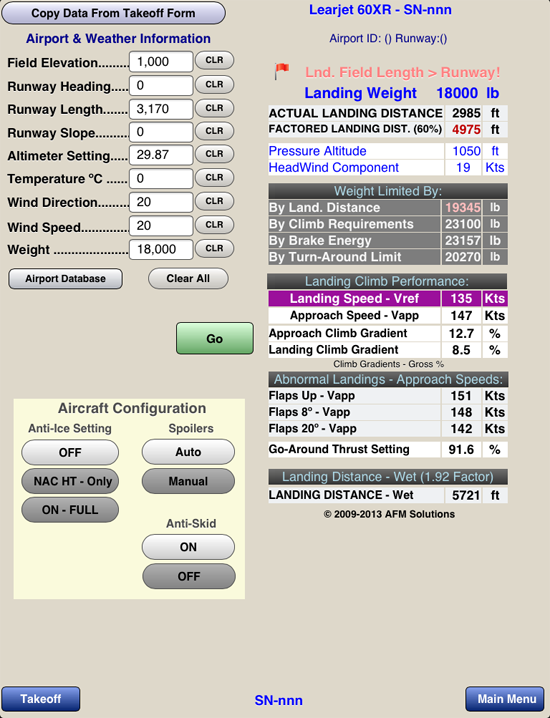AFM Solutions - Aircraft Performance And Weight And Balance Software
Main menu:
Aircraft Performance App For Learjet 60XR
Examples
We have software for over 50 different types of aircraft and are adding new aircraft to the list as they become available.
After computing the weight and balance, if any of the values are out of limits, the program will alert you to that effect.
The takeoff weight of 23478 pounds is automatically transferred to the takeoff form for your convenience.
The landing weight of 17520 pounds is automatically transferred to the landing form for your convenience.
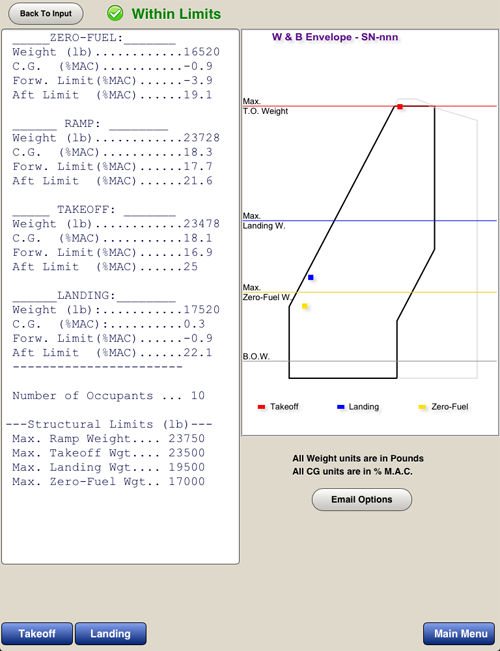
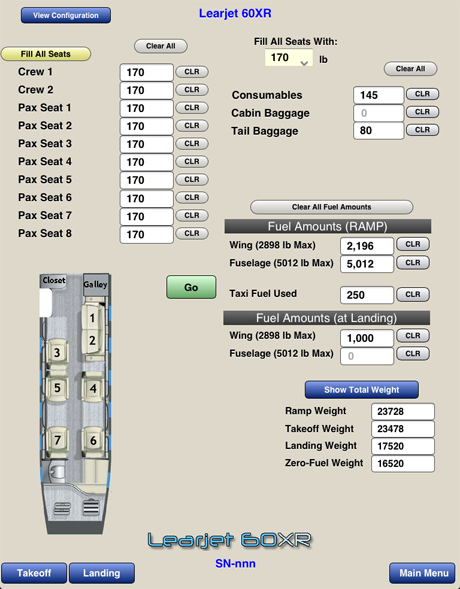
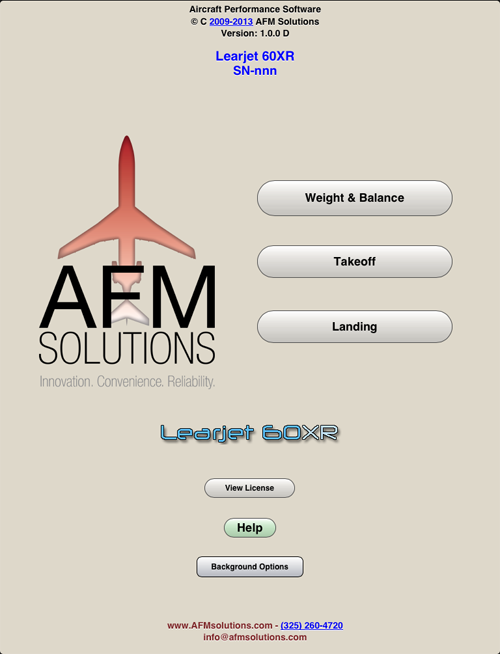
The main menu allows you to quickly jump to any other part of the app.
TAKEOFF EXAMPLE
Let's take a look at a takeoff example below:
Before any calculations are made, the program always checks all the following:
- Structural Weight Limit
- Weight Limited by Climb Requirements
- Brake Energy Weight Limit
- Weight Limit due to Runway Length
- Weight Limit due to Obstacle (if any)
- Weight Limit due to a Required SID Gradient (if any)
1 - The OAT is 60 ºF, or 15.56 ºC as shown in the input section.
2 - The crew would like to take off with a gross weight of 22000 pounds. The "Proposed Weight" check-box is therefore checked and the program is using 22000 lb.
3 - There are no obstacles to clear and there is no required SID gradient, so "None" was checked here.
4 - The aircraft will take off with flaps 8 degrees, Anti-Ice Off, Rudder Boost On, APR/Autospoilers Armed and Anti-Skid On.
5 - The Altimeter Setting being 29.92 and Temperature 15.56 ºC, the pressure altitude is 2000 ft and the Deviation from ISA temperature is 4.5 deg. C.
6 - With no obstacles or SID gradients involved the leveloff altitude is assumed to be 400 ft above runway. The Maximum Continuous Thrust setting is therefore computed at 400 ft or pressure altitude of 2400 ft.

Here the "Use Proposed Weight" check-box is unchecked. Therefore, the program ignores the proposed weight of 22000 lb and uses the MTOW of 23500 lb.
However, in this example the weight is limited to 22750 lb due to the length of the runway.
By checking or unchecking this box, one can easily determine the Maximum Takeoff Weight Allowed under the given conditions. But the program can quickly calculate the performance numbers for a lower weight (22000 lb in the above example) if desired.
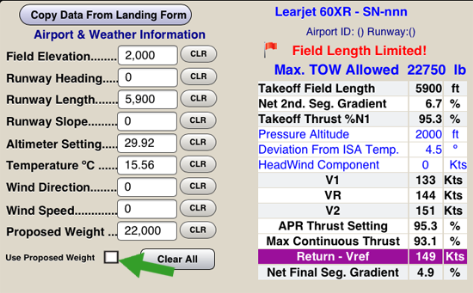
Takeoff Example Involving an Obstacle
1 - In the next example the aircraft must clear an obstacle that is located 12000 ft from the end of the runway and is 900 ft high.
The runway is 5900 ft long with a slope of 0.8% down (or -0.8%).
The runway heading is 320 degrees and the wind is reported to be 350 deg. at 20 Kts resulting in a headwind of 17 Kts
The temperature (OAT) is 27 ºC.
The aircraft configuration is the same as in the previous example.
2 - Under these conditions the Maximum Takeoff Weight Allowed is 20972 lb.
The runway length of 5900 ft is no longer the most limiting factor.
The weight had to be reduced in order to clear the obstacle.
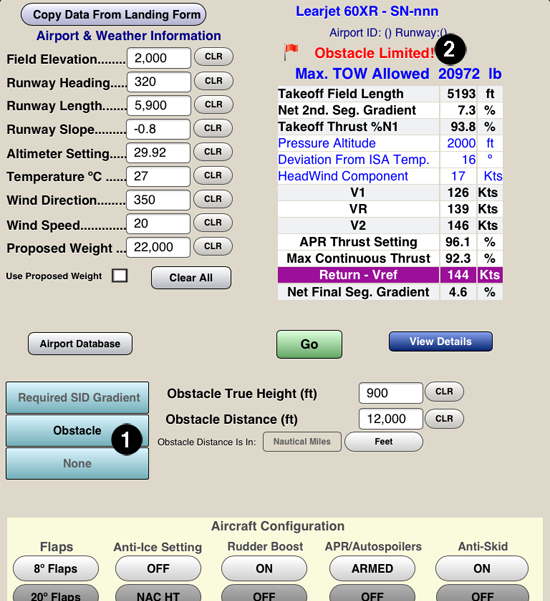
In this example we have selected Flaps 20º. instead of 8 deg.
The MTOW Allowed in this case is 19900 lb, which is lower than the weight using Flaps 8º as seen in the previous example.
Even though the takeoff field length is only 4355 ft, the climb performance is not as good.
Takeoff With 20 Degrees of Flaps
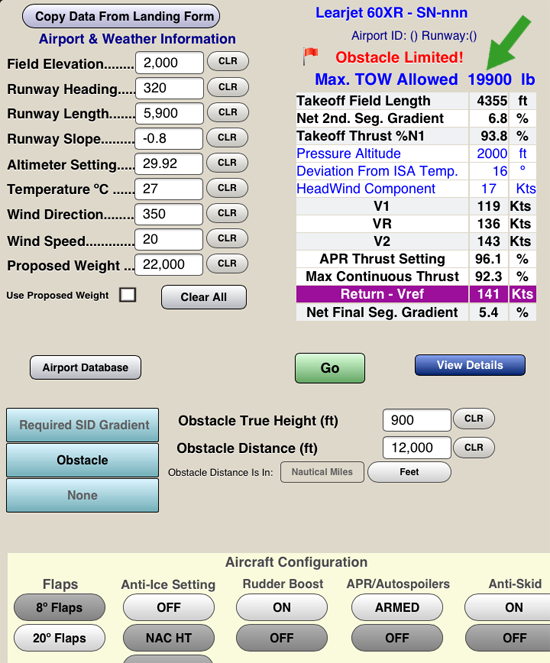
The Above Example With Details Shown:

When the blue "View Details" button is pressed, a small pop-up window opens to give you all the details.
Any weight limit resulting in a value that is less than 23500 lb is displayed in red.
In this example the weight limit due to obstacle is lower than the limit due to runway length.
The program always calculates the Maximum Continuous Thrust setting and the Final Segment Gradient at the level-off altitude.
The temperature corresponding to the level-off altitude is adjusted for the standard drop of -2 deg. C for every 1000 ft of altitude above runway. For any obstacle resulting in a Gross Level-Off Height of less than 1500 ft, the program uses 1500 ft as level-off height. In case there are no obstacles, the level-off height is set to 400 ft.
In this case, the value of MCT = 92.3% was obtained at the pressure altitude of 3500 ft and temperature 24 ºC
Since the Runway Length is 5900 ft and the Takeoff Field Length is 4355 ft, the Remaining Unused Runway Distance is 1545 ft (5900-4355)
Our Last Example Shows the Same Takeoff As Above But With Flaps Set to 8º
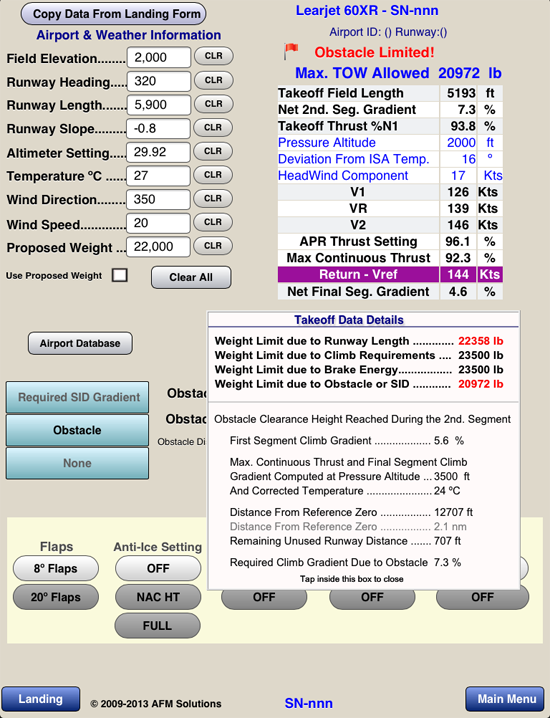
Landing Screen
